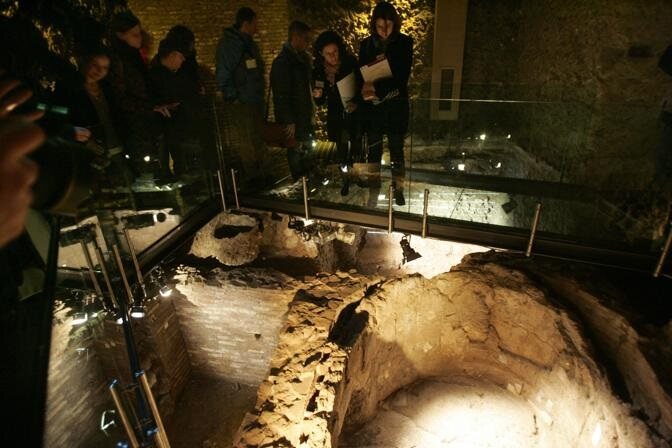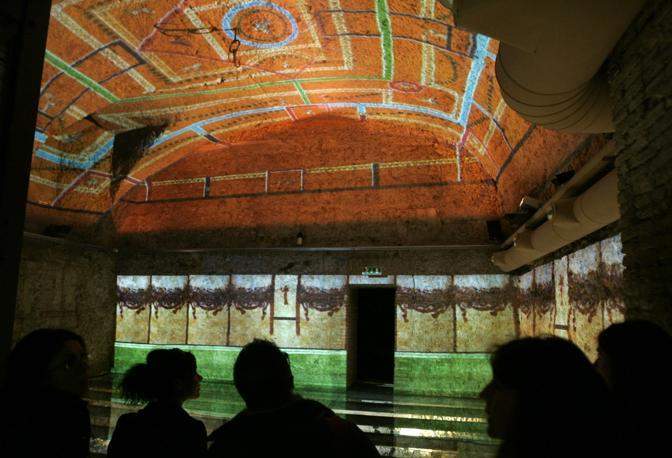The history of Palazzo Valentini
Palazzo Valentini is located in front of Foro Traiano. The Palace as it looks today is the result of a series of renovation works commissioned by Cardinal Michele Bonelli in 1585.
In 1752, the palace was sold to Cardinal Giuseppe Spinelli, who commissioned new works including frescoes on the main floor – usually the first floor –, which was where the owner’s family used to live. The team of artists in charge was led by the painter Stefano Pozzi.
The name Palazzo Valentini dates back to 1827, when the palace was purchased by the banker Vincenzo Valentini. The new owner had other important works carried out, adding many works of art. Some of them are still housed in the palace.
Today, the building is the seat of the Metropolitan City of Rome, which bought Palazzo Valentini in 1873 and built, among other things, the City Council Chamber. The Prefecture of Rome is also located here.
An important archaeological site called Domus Romane di Palazzo Valentini was discovered under the palace in 2005.

The exhibition route of Valentini Palace Domus
The visit to the Domus of Palazzo Valentini includes three archaeological zones.
- The reception rooms of the Domus, where the master of the house would entertain his guests.
- The area of the baths that were inside one of the domus.
- The remains of a public building, most probably a temple dedicated by the Emperor Hadrian to Trajan and Plotina Divi, who were both deified after their deaths.
Inside the museum, rooms exhibiting archaeological finds and multimedia solutions are alternately arranged. The most important or best-preserved finds from the excavations are on display in the various rooms. There are remains of daily use pottery – such as plates for eating and cooking vessels –, and amphorae for carrying wine. But there are also fragments of floors or sculptures that most probably decorated the baths or the reception rooms of the domus, as well as coins and decorated glass vessels.
The last of the rooms is housed in a bunker, still in its original layout, built under the Palace during World War II.
The archaeological findings of the Roman Domus
Of the two domus found during the excavations, one probably dates back to the beginning of the Hadrianic period, around AD 125, the other to the end of the 2nd century AD, around AD 180.
The current appearance is the result of renovations that took place in the 4th century AD, more precisely between 320 and 350 AD. The floors of all the domus rooms certainly date back to this period.
Beautiful mosaics, decorated walls, floors with polychrome marble, i.e. of various colours, and the remains of frescos have been found inside these dwellings, recounting the splendour of Imperial Rome.
Of particular interest is the rich floor mosaic in the triclinium area. Actually, the logo of the Roman Domus of Palazzo Valentini features a detail of this floor.
Within the archaeological site, in the area of the baths, there is also evidence, as was usual, of a heating system designed to distribute the heat generated by a wood boiler across the various rooms.

Piero Angela, Paco Lanciano and Multimedia Technology
With the progress of excavations and the discovery of important finds, an innovative project was begun in 2007. Using immersive multimedia technology, visitors would be offered a more effective, meaningful and enjoyable tour of the archaeological site of the Roman Domus of Palazzo Valentini. This project was a great novelty in the international museum scene in those years.
Two well-known science popularisers, Piero Angela and Paco Lanciano, were involved in designing the multimedia itinerary.
Using projectors, animations, and special effects, the original appearance of the buildings has been reconstructed, with their original wall structures, decorations, and furnishings.
In 2023, several actions were taken to relaunch the Domus site, including a major restoration of the technological system supporting multimedia narration. Using latest-generation, ultra-high-definition video projection systems, visitors are now being offered a deeper and more emotional experience. The audio system – which plays an important role in the construction of an immersive experience – was also completely upgraded. It now features individual headphones for visitors ensuring high quality commentary and soundtrack. The combined effects of the new projection technology and audio system deeply engage visitors, giving them an unforgettable immersive experience of the Domus. Also, a multilingual guide is available with the new audio system featuring individual headphones. In the Italian version, in particular, the Domus history is narrated by Piero Angela, while for the other languages the text was translated and interpreted by professional actors.
The relaunch of the Domus of Palazzo Valentini also includes the creation of this website accessible for people with hearing, visual, cognitive and motor impairments.
